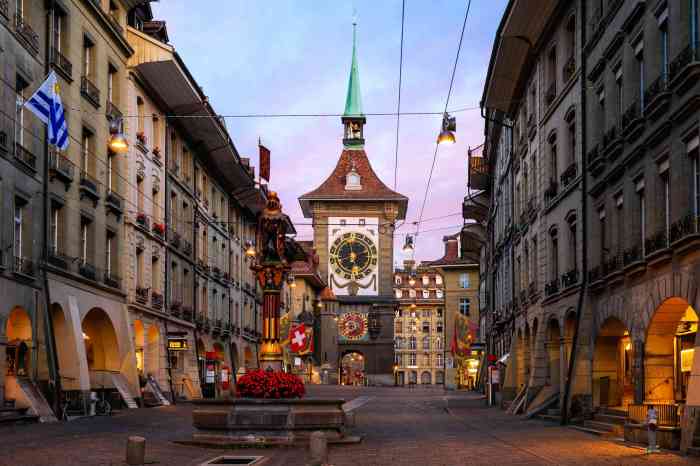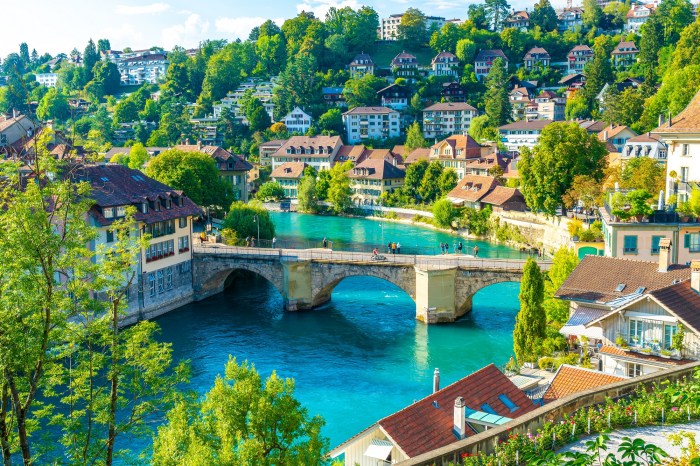Bern, the charming capital of Switzerland, boasts a rich tapestry of history, culture, and natural beauty. From its humble beginnings as a medieval city-state to its modern-day status as a vibrant metropolis, Bern has played a pivotal role in shaping the Swiss nation.
Nestled amidst the rolling hills of the Swiss Plateau, Bern’s origins can be traced back to the 12th century, when it was founded by Duke Berthold V of Zähringen. Over the centuries, Bern grew into a powerful city-state, expanding its territory through conquest and diplomacy. Its strategic location at the confluence of the Aare and Saane rivers made it a major trading hub, contributing to its economic prosperity.
Historical Context of Bern

Bern, the capital of Switzerland, has a rich and storied history that dates back to the 12th century. The city was founded by Berchtold V, Duke of Zähringen, in 1191. Berchtold chose the site of Bern because of its strategic location on the Aare River, which provided access to trade routes and natural resources.
The Zähringer Dynasty
The Zähringer dynasty played a significant role in Bern’s early history. Berchtold V and his successors granted Bern numerous privileges, including the right to hold markets and mint coins. They also established a system of self-government that allowed Bern to develop its own laws and institutions.
Development as a City-State
In the 13th and 14th centuries, Bern gradually expanded its territory and became a powerful city-state. The city’s wealth and influence grew through trade, banking, and military conquests. Bern also established alliances with other Swiss cities and played a leading role in the Swiss Confederation.
Political Structure and Governance

In the Middle Ages, Bern’s political system was characterized by a complex interplay between the patriciate, guilds, and the city council.
Bern is not only a beautiful city but also home to numerous art galleries. Among them, the accademia gallery stands out with its impressive collection of paintings and sculptures. Whether you’re an art enthusiast or simply appreciate beauty, this gallery is worth exploring during your visit to Bern.
The patriciate, a small group of wealthy and influential families, held a dominant role in Bernese politics. They controlled the city council, which was responsible for governing the city and making laws.
The Role of Guilds
The guilds, representing different trades and professions, also played a significant role in Bern’s political life. They had the right to elect members to the city council, and they often used their influence to promote their economic interests.
Evolution of Bern’s Political System
Over time, Bern’s political system evolved. In the 14th century, the city council was enlarged to include representatives from the guilds. This gave the guilds a greater voice in the city’s government.
In the 16th century, Bern adopted the Reformation. This led to a decline in the power of the patriciate and an increase in the influence of the guilds.
By the 18th century, Bern had become a republic. The city council was now elected by all male citizens, and the patriciate had lost its privileged position.
Economic and Cultural Development

Bern’s economic prosperity was fueled by several factors. Its strategic location at the confluence of the Aare and Saane rivers made it a crucial trade hub. The city’s control over key Alpine passes facilitated the transportation of goods between northern and southern Europe.
Bern, the beautiful Swiss capital, is a must-see destination for any luxury traveler. Explore the city’s historic streets and visit the Bundeshaus, the Swiss Parliament building. For a truly unforgettable experience, indulge in luxury travel deals that offer exclusive access to Bern’s finest hotels, restaurants, and attractions.
After exploring the city, take a day trip to the nearby Bernese Alps for breathtaking views and outdoor adventures.
Bern’s economy flourished through a diverse range of industries, including textiles, metalworking, and printing. Agriculture also played a vital role, with the surrounding countryside providing ample food supplies. The city’s wealth allowed for significant cultural achievements.
Architecture
Bern’s architectural heritage is renowned for its medieval charm. The Old Town, a UNESCO World Heritage Site, showcases a blend of Gothic and Renaissance styles. Notable landmarks include the Zytglogge, a 13th-century clock tower, and the Bern Minster, a magnificent cathedral with a towering spire.
Art
Bern has a rich artistic tradition. The Kunstmuseum Bern houses a renowned collection of paintings, sculptures, and drawings from various periods. The city is also home to the Zentrum Paul Klee, dedicated to the works of the influential Swiss artist.
Literature
Bern has produced several literary figures. The 19th-century novelist Jeremias Gotthelf captured rural life in his works. In the 20th century, Hermann Hesse, a Nobel laureate, wrote introspective novels exploring themes of identity and spirituality.
Bern’s Role in Swiss History
Bern played a pivotal role in the formation and development of the Swiss Confederacy, as well as in Swiss politics and diplomacy.
Role in the Formation of the Swiss Confederacy
Bern joined the Swiss Confederacy in 1353, becoming one of the eight founding cantons. It played a key role in the expansion of the Confederacy, participating in numerous battles and conquests against neighboring territories.
Involvement in the Swiss Reformation
Bern embraced the Protestant Reformation in 1528, under the leadership of reformer Guillaume Farel. The city became a center of Protestant thought and played a significant role in spreading the Reformation throughout Switzerland.
Contributions to Swiss Politics and Diplomacy, Bern
Bern was a dominant force in Swiss politics for centuries. It held the position of “Vorort” (leading canton) of the Confederacy on multiple occasions and played a key role in shaping Swiss foreign policy and diplomacy.
Modern-Day Bern

Bern, the capital of Switzerland, remains a vibrant and dynamic city in the 21st century. It has evolved politically, economically, and culturally, adapting to modern challenges and opportunities while preserving its rich heritage.
Political and Economic Landscape
Bern’s political system is characterized by a strong emphasis on consensus and collaboration. The city government is led by an executive council, which is elected by the municipal parliament. The parliament, in turn, is elected by the citizens of Bern.
Bern’s economy is diverse, with a strong focus on services, including finance, healthcare, and tourism. The city is also home to a number of multinational corporations, including Nestle and Swisscom.
Bern’s stunning architecture and rich history captivate visitors, but its proximity to pristine beaches offers an idyllic escape. Just a short drive away lies Anini Beach , a tranquil paradise with crystal-clear waters and soft, white sands. Here, you can soak up the sun, snorkel amidst vibrant marine life, or simply relax and enjoy the breathtaking coastal scenery.
After a day of beach bliss, return to Bern and immerse yourself in its cultural treasures once more.
Challenges and Opportunities
Like many cities, Bern faces a number of challenges in the 21st century. These include:
- Climate change: Bern is committed to reducing its greenhouse gas emissions and becoming a more sustainable city.
- Affordable housing: Bern is working to provide affordable housing for its residents, especially those with low incomes.
- Transportation: Bern is investing in its public transportation system to reduce traffic congestion and improve air quality.
Bern also has a number of opportunities in the 21st century. These include:
- Education and innovation: Bern is home to a number of universities and research institutions, which are helping to drive innovation and economic growth.
- Tourism: Bern is a popular tourist destination, attracting visitors from around the world. The city is working to promote sustainable tourism and preserve its cultural heritage.
- International cooperation: Bern is an active participant in international organizations, such as the United Nations and the World Health Organization. The city is committed to working with other countries to address global challenges.
Cultural and Tourist Destination
Bern is a vibrant cultural and tourist destination. The city is home to a number of museums, art galleries, and theaters. Bern is also known for its beautiful architecture, including the Zytglogge, a medieval clock tower, and the Bundeshaus, the Swiss parliament building.
Bern attracts visitors from around the world with its unique blend of history, culture, and natural beauty. The city is a popular destination for both leisure and business travelers.
Outcome Summary

Today, Bern remains a vibrant and dynamic city, balancing its rich heritage with modern progress. Its well-preserved medieval architecture, including the iconic Zytglogge clock tower, transports visitors back in time, while its contemporary art galleries and museums showcase the city’s cultural vitality. Bern is also a culinary paradise, renowned for its traditional Swiss dishes and its thriving international cuisine.
As a testament to its enduring significance, Bern’s Old Town was designated a UNESCO World Heritage Site in 1983. With its picturesque streets, charming fountains, and stunning views of the surrounding Alps, Bern continues to captivate visitors from around the world.
FAQ Corner
What is Bern famous for?
Bern is famous for its medieval architecture, including the Zytglogge clock tower, its role in Swiss history, and its vibrant cultural scene.
What is the population of Bern?
As of 2023, the population of Bern is approximately 143,000.
What is the official language of Bern?
The official language of Bern is German, specifically the Bernese German dialect.